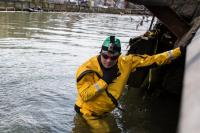
Photo:Kirsten Luce for The New York Times
Christopher Swain, an environmental activist, spent about an hour swimming in New York’s Gowanus Canal earlier this week on Earth Day. He said he made his swim as a “call for an accelerated cleanup of the Canal.” The Gowanus Canal is a 1.8-mile-long waterway connecting Upper New York Bay (the bay in between Brooklyn, Manhattan, New Jersey, and Staten Island) with the formerly industrial interior of Brooklyn. It is also one of North America’s most polluted waterways and has been a “Superfund” site since 2010. In 2013, the Environmental Protection Agency developed a cleanup plan which is expected to cost $506 million and should be completed by 2022. It is unclear how Mr. Swain’s swim will speed up the process.
While Swain wore a protective suit during his swim in the canal polluted with sewage and industrial chemicals, his mouth was still exposed. The New York Times reports that “a volunteer kayaked alongside him, holding a bottle of hydrogen peroxide for him to gargle with whenever his unprotected mouth strayed too close to danger.”
What would happen if you drank water from the Gowanus Canal? It just so happens to that the magazine Popular Science asked that question in 2013 with their article, appropriately titled, “What Would Happen If You Drank Water From The Gowanus Canal?” Dan Nosowitz writes:
“So, right off the bat, you’d have a massive problem with dysentery,” Ludgen Balan, founder of the Urban Divers Estuary Conservancy, told me. Dysentery, caused by an infection from hostile bacteria or amoebas, results in severe diarrhea, likely with some blood and mucus added as a bonus. That was the very first thing Balan told me, and the more I looked into the Gowanus Canal, an absurdly, laughably polluted waterway right smack in the middle of gentrified Brooklyn, the more I realized that dysentery is one of the least repulsive things about the Gowanus.
…The Gowanus is one of the most creatively and massively pathogenetic waterways on the planet. We know some things; we know that the quantity of fecal matter, usually measured in parts per million, can be measured in parts per hundred in the Gowanus. But the Gowanus isn’t any one thing; water taken from different parts of the canal, from different depths, will have totally different levels of contaminants, microbes, radioactive materials, or carcinogenic materials.
And what did Christopher Swain think of the Gowanus water? As reported by the NY Times: “It tasted like mud, poop, ground-up grass and gasoline,” he said, answering the question on the minds of everyone present. Its texture was gritty, he said, like drinking another famous Brooklyn specialty, any sort of healthful green juice.”
Swain’s swim was cut short by the weather. After swimming 2/3rds of a mile Swain came ashore because of reports of a potentially severe thunderstorm on the horizon. He says that he will return to swim the the entire length of the canal. Perhaps he should wait for 2022.

Pingback: New York’s Gowanus Canal — Watch out for the Three-Eyed Catfish | News For Mariners